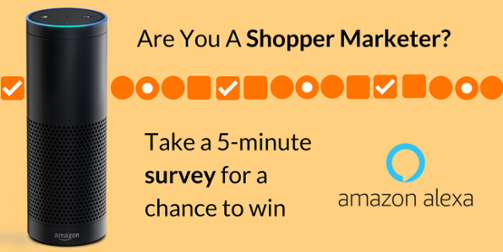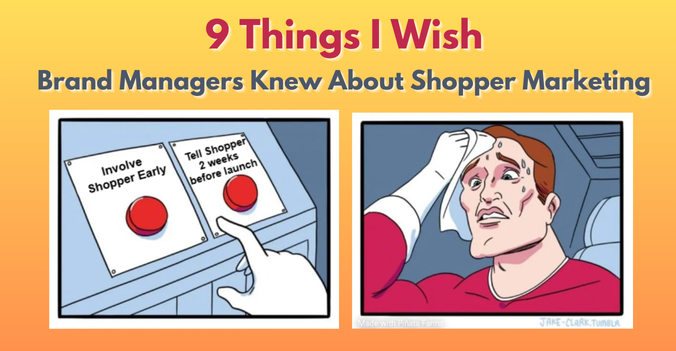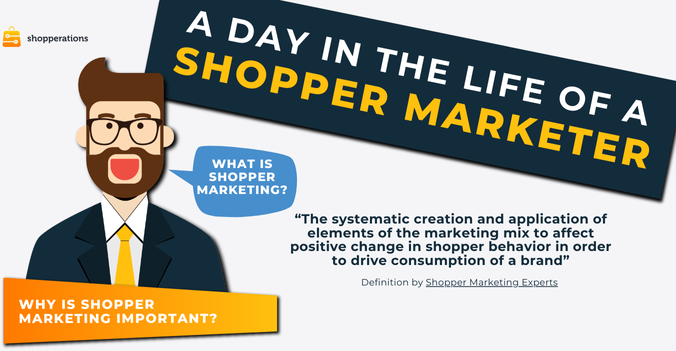.png?width=501&name=Rookie%20Shopper%20Marketers'%20Mistakes%20(5).png) One of our most popular blog articles is “10 Rookie Shopper Marketer’s Must Dos.” The practical tools and strategies we talked about continue to be reflective of the growth of shopper marketing around the globe, and across all CPG sectors. If you’ve already completed your initial on-boarding (and are no longer drinking from a firehose), check out this list of some typical mistakes shopper marketers make. It is a compilation of testimonials, or “stories from the trenches” we collected over the years from seasoned shopper marketing executives. These folk have been around the block and dealt with the frustration and embarrassment of not getting it right on the first try. Their real identities have been hidden for their own protection (but there’s no judgment here! We’ve all been a rookie).
One of our most popular blog articles is “10 Rookie Shopper Marketer’s Must Dos.” The practical tools and strategies we talked about continue to be reflective of the growth of shopper marketing around the globe, and across all CPG sectors. If you’ve already completed your initial on-boarding (and are no longer drinking from a firehose), check out this list of some typical mistakes shopper marketers make. It is a compilation of testimonials, or “stories from the trenches” we collected over the years from seasoned shopper marketing executives. These folk have been around the block and dealt with the frustration and embarrassment of not getting it right on the first try. Their real identities have been hidden for their own protection (but there’s no judgment here! We’ve all been a rookie).
1. Running a shopper marketing function from HQ
“Due to a prolonged hiring freeze, we were unable to establish a field-based shopper marketing team, and for the longest time, it was just me and my manager running the shopper organization out of headquarters. Both of us had small kids and were unable to travel full time, so we tried to manage the business via conference calls and occasional in-market visits. That didn’t work out too well. We were always extremely busy, but I never felt we were the experts in our retail customers’ marketing strategies because our customer relationships were weak. Brand teams viewed us as a bottleneck and eventually learned to bypass us and go straight to Sales to discuss strategy. It was a tough situation for a while, but things turned around once we expanded the team and developed deep customer expertise by having ‘feet on the ground’.”
2. Believing any agency can do shopper marketing
“We had this awesome digital agency our brand team loved and highly recommended. When we announced our shopper marketing agency pitch competition, we included them into the process. We could sense that they lacked shopper marketing expertise, but we believed we could learn together plus they already knew our brands so well and they had a great relationship with our brand team. After giving them a chance, we quickly realized that the retail world is a completely different story from a digital marketing world. Things are messier, less driven by the data and more by the relationships. Our sales teams were frustrated that they had to teach us — and our agency — basic stuff about how retail worked, and that the ideas the agency proposed could never be executed at many of the retail customers’ stores. We wished that our new SM team had a more seasoned shopper marketing agency partner.”
3. Not investing in shopper insights capability
“For the first couple of years of doing shopper marketing, we were treading the waters and could not figure out a way to elevate our relationship from a transactional to a strategic one because it was hard for us to differentiate from other CPGs. All we brought to the retailer’s table was some money and a product portfolio. It was getting harder by the day to impress retailers even with data since they have access to their own, robust data sets. At some point, we realized that to make our retail partners pay attention, we had to show them something they didn’t already know. So, we commissioned ethnographic studies that went deep into aspirations and attitudes around meal preparation and helped us come up with a new shopper marketing framework for how meal planning and shopping for food feeds into family dynamic. That research revealed what problems shoppers faced when deciding on, shopping for and preparing family meals, how retailers could help and what messaging would resonate with them. This research was a hit with retailers, it fuelled multiple top-to-top conversations and numerous retail executions because insight like this cannot be gleaned from the point-of-sale data alone.”
4. Developing cookie-cutter campaigns for all key accounts
“I come from Consumer Promotions background. In my early shopper marketing days, I came up with this awesome tailgating promotion I thought would be a massive success because it was grounded in shopper insights, supported by a multi-touchpoint national campaign, had awesome recipe content and was packaged in a glorious selling deck. What else would a sales team need to make it happen? Well, what I learned is that the timing of my proposed campaign conflicted with the retailers’ promotional themes at our two top accounts. The featured products in all of my key visuals had less than 60% distribution in three out of top five accounts, making the digital assets and recipes we prepared useless. We spent a lot of time reworking and re-packaging the program and ended up being late to present to several retail accounts that had longer sell-in lead times. This experience taught me to get my field teams involved in initial planning conversations and not to “fully bake” the ideas until they are presented for retail customer input. That means starting planning waaay earlier.”
5. Taking on too much
“Early in my career, I tried to please everyone. I wouldn’t even push back when a tiny brand wanted me to develop detailed shopper marketing plan or non-priority customer teams called for help with executing their tactical programs. Our team ended up being seen as a “catch-all” for all the extra marketing work at anyone needed to do, so we were assigned digital & social media, content creation and e-commerce capabilities... all vastly different disciplines that required specialized skill sets. Our team was too small and over-extended. We didn’t accomplish any major breakthroughs in either of these areas until we learned how to prioritize and cut back on the number of people we needed to please. Determining and sticking to our top 5 key accounts and top 3 priority brands made a world of difference and helped us achieve some serious wins.”
6. WAITING FOR THE BRAND PLANS TO FINALIZE
“In a perfect world, brands release their marketing plans to the field early in order to enable effective program sell-in. I was a young, (read naïve) newly appointed shopper marketing team lead, and I had the ambition to make this dream a reality. I went about it by insisting that the integrated marketing planning process started sooner and the timelines were compressed. I quickly learned the process was complex for a reason; that this monstrous machine could not be sped up (at least not with my level of authority), therefore my demands were not accommodated. For many months, I felt resentful and victimized until one day I had the proverbial light bulb moment. I was meeting with a consultant who suggested that instead of demanding the information, I should proactively share it. His theory was that by initiating the conversation in a giving way, I was in a better position to build trust and influence the brand plans. His wisdom completely shifted how I thought about my role in enacting change.
I tasked my account-facing teams to develop a short list of high-level, strategic customer insights and recommendations to each priority brand, which we then presented prior to the planning season. We had incredibly fulfilling, strategic conversations with the brands because we didn’t come asking for money. Turned out, they craved this early input about key customer strategies and partnership opportunities. We were able to convince at least a couple of big brands not to wait till plans were final to share “work in progress” with us and our customers. That year, plans were finalized no sooner than in the past, but they brought no surprises, and we could see our own and our customers’ fingerprints all over them. Some call it ‘store-back planning,’ I call it ‘trust and common sense.’”
7. NOT ADDRESSING BRAND OVER-REACH
“One of the mistakes I made (and I see my industry peers repeating) is operating not like a strategic function, but rather like a tactical extension of the brand in retail, thus allowing my team to be micromanaged to death. Instead of relying on the customer experts and empowering my team to make investment decisions on the fly, based on the quickly changing retail landscape, I watched headquarter-based brand and finance teams approve every small investment decision. Need to move a promotion from Q1 to Q2 because customer merchandising plans moved? Good luck explaining a bunch of people in the headquarters why it must be done! Changed your mind and decided to try a new digital tactic instead of a print ad? Go through fifteen emails and three conference calls to get a “go-ahead” from the brand manager. Brands behave this way because they don’t know any better, and because they “don’t see the forest for the trees.” Our problem was that there was a high degree of opacity and mistrust that drove all this unnecessary process. To end this madness, we officially cut the cord from the brand P&L by establishing a shopper marketing “tax” and pooling all funds into one large bucket for each key customer team. In return, we established:
- a strong briefing process where brands informed us of the strategic imperatives, goals and new product plans
- a culture of extreme transparency by sharing program results with brands, both successes and especially failures;
- a rigorous ROI measurement process to demonstrate tangible contributions that our team made to the bottomline
When you consistently deliver better ROI than traditional Media or Trade, it’s easy to insist your team is not micromanaged.”
8. MIS-ALIGNING KPIS WITH KEY CONSTITUENTS
“When the shopper marketing function was first established, we wanted to create a set of metrics that were unique to shopper marketing, to help illustrate the results only we could claim. We considered household panel data, shopper card data, as well as softer, relationship-oriented metrics that were intended to capture the degree of strategic collaboration with our retail customers. However, due to small household panel sample sizes, we couldn’t measure individual program impact across all customers. Due to the the subjective nature of the relationship-based metrics, we abandoned them as well. We also noticed that our desire to set up a new set of metrics met with resistance from brands and sales who expected us to help them drive their agenda. In the end, we borrowed some metrics from brands (account-specific market share and brand equity scores) and some from Sales (account-specific net sales, points of distribution and profitability) and aligned our performance measurement structure accordingly. The change in the tone of the conversations between our teams was almost palpable, we knew we were winning our key partners’ hearts and minds when we showed them how our shopper marketing agenda complements theirs. We had to learn to speak their language for us to be successful.”
9. FAILING TO SET CLEAR SPENDING PRINCIPLES
“My biggest challenge to overcome as a shopper marketer had been to manage internal expectations about what our budgets should, and even more so, should NOT be spent on. There was a lot of ambiguity around what shopper marketing really was, and how the budgets should be allocated across our marketing mix. There was a lot perceived overlap with Traditional Media and Trade, and the lack of clear shopper marketing spending principles forced us to spend countless hours either arguing with Sales about not using shopper marketing funds as a Trade “slush fund” or with central Media Planning team about the need to buy retailer-specific media independently. We were able to overcome this challenge only after senior sales, marketing and shopper marketing leaders aligned and documented formal “spending principles” that regulated overlapping grey areas. This document helped manage expectations and gave the shopper team “air cover” to continue focusing on the execution and less on turf protection and finger-pointing. I only wish we did it sooner.”
10. NOT STANDARDIZING SHOPPER MARKETING OPERATIONS
“I found myself promoted and leading a geographically-dispersed shopper marketing team that was really good at what they did. I had a lot of respect for them and didn’t intend to micromanage. However, I quickly realized that, as a middle-manager, I was expected to know a lot about their work. My meetings with Brands and Finance were always very frustrating because I felt unprepared, uninformed and had to “get back to them” with the answers. Later, these follow-up questions would distract my team from their main jobs, and made me feel terrible about wasting their time. A senior manager demanded a “Playbook” to keep him informed, and that request triggered a new workstream to create a large PPT deck that someone had to update regularly. This is not what I had in mind when I signed up to lead the shopper marketing function, so I had to find a better solution. I realized that my team had all the answers in their offline trackers, and because they were very experienced, they ran their business units independently and came up with own ways of tracking budgets and plans. Unfortunately, all of these tools looked different and were completely non-standard. After a thorough audit of the essential operational data and standardization exercise, we were able to come up with one common way of planning and tracking our activities that rolled into a unified report. We needed a centralized dashboard that gave both me and my peers in headquarters the ability to monitor real time data. Do not repeat my mistake by being a ‘hands-off’ manager. Accountability and transparency should be mandated, and there are ways to achieve them while empowering the team to make decisions and without micromanaging them.”




.png)

.png)




